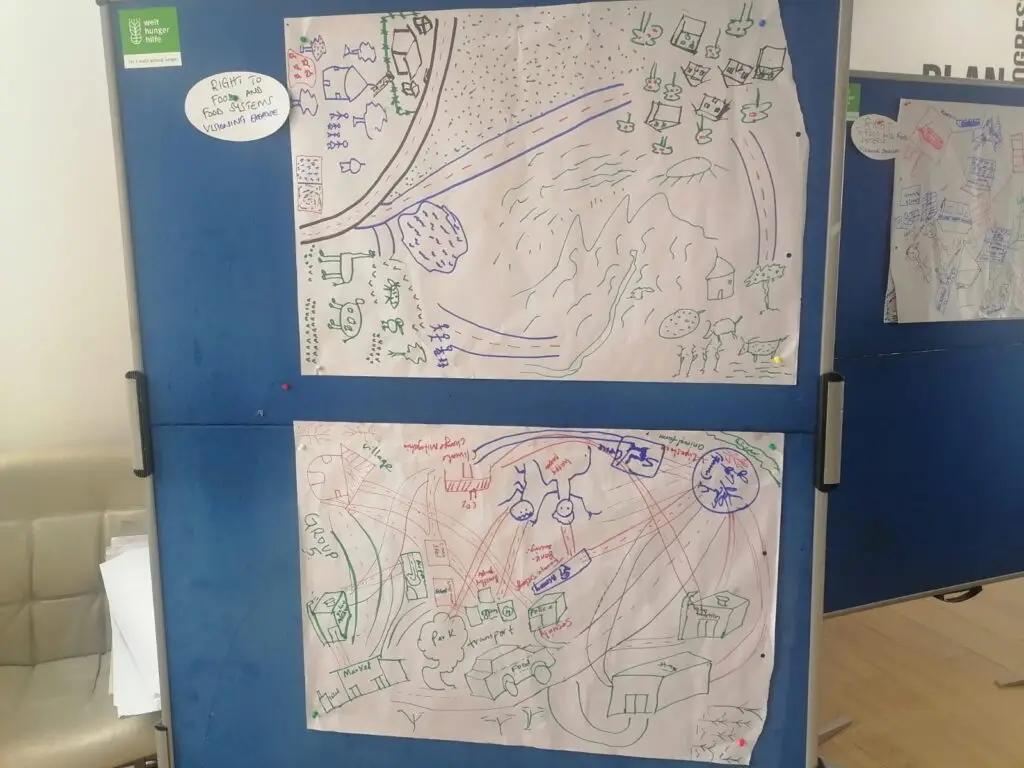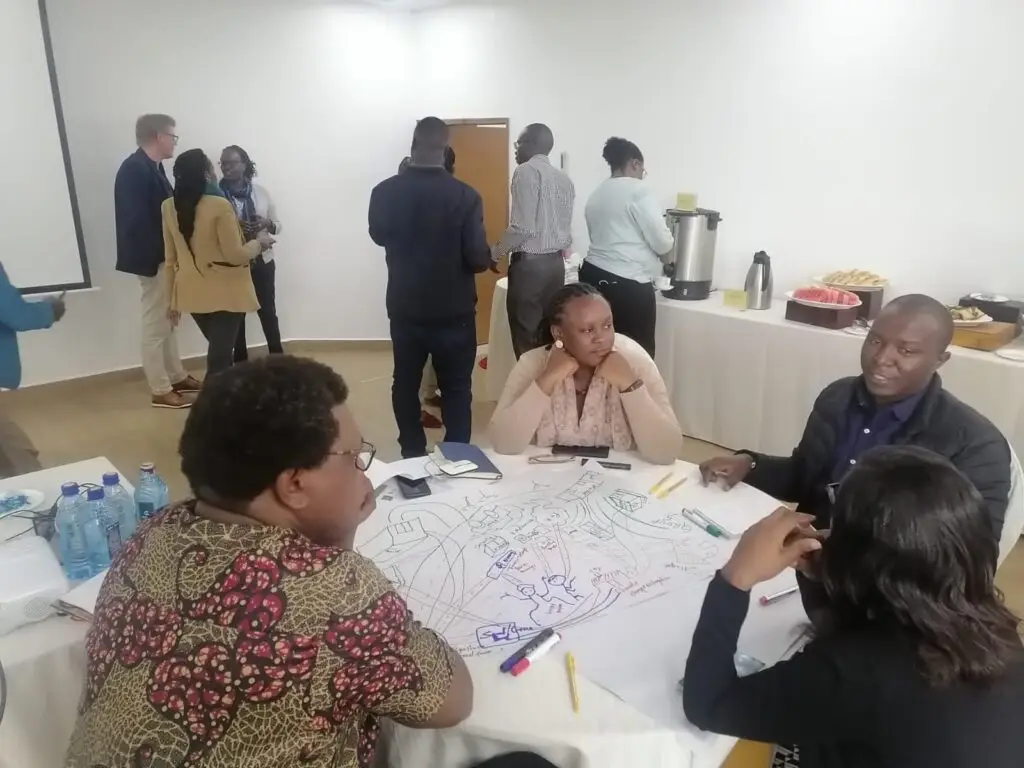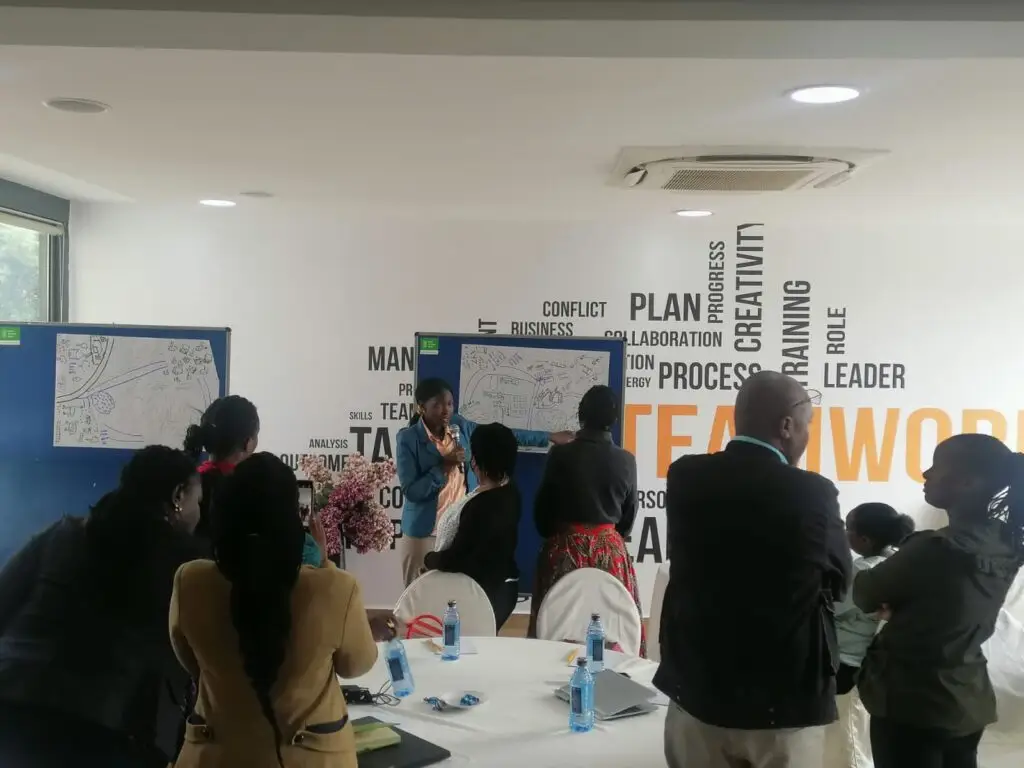Food is the moral right of all who are born into this world. Yet nearly one in three people in the world (2.37 billion) do not have access to adequate food, close to two-thirds (60%) of the population in Africa. According to the State of Food Security and Nutrition in the World (SOFI 2021) report, world hunger increased by almost 320 million people in 2020. More than one-third (282 million) of the worlds undernourished are found in Africa.
Right to Food Workshop-Deliberations on a vision for Realisation of the Right to Food in Kenya

In Kenya, 68.5% of the population is moderately or severely food insecure, and about 25% of the population is undernourished. In September 2021, some 2 million Kenyans are facing certain hunger, an increase from 1.4 million in March 2021. Drought is affecting half the counties in the country and the number of hungry persons is projected to reach 3 million by December 20211.2.1 million people in Kenya are malnourished.2The problem of food insecurity in Kenya is linked to economic inequalities, social exclusion, corruption, high poverty in rural areas, decreased agricultural productivity, high food prices, drought, floods, conflict, and climate change.
Experience sharing on Culture and Food in the Kenyan Context

The high burden of malnutrition and routine hunger in Kenya is not only a threat to the achievement of the goal of Kenya Vision 2030 and the Sustainable Development Goals (SDGs) but also a clear indication of inadequate realization of human rights. In the Constitution of Kenya 2010, two articles are explicit on the right to food. Article 43 (1)(C) states “Every person has the right to be free from hunger, and to have adequate food of acceptable quality”; and Article 53 (1)(C) “Every child has the right to basic nutrition, shelter and health care”. There are several laws (Acts) that talk about food, but we do not have a specific right to food Act – a framework law to support legally binding obligations to realiSe the right to food. Agriculture and food and nutrition policies, cognisant of the right to food, try to address the country’s food and nutrition challenges with limited success; mostly from a needs-based perspective rather than from a rights approach.
Consultations with and research done by stakeholders revealed that there is a need to develop a robust legal framework for the Right to Food to give life to the constitutional provision in Article 43 (1) (c). The Article is an important milestone towards the realisation of the right to food, but not sufficient as it does not provide an elaborate framework to actualise the right. Hence the goal is to have a comprehensive legal framework that sufficiently translates the constitutional entitlement on the right to adequate food enacted and rolled out with requisite policies, accountability and redressal mechanisms, institutional arrangements, and resources by 2030.
To enable effective advocacy for the right to food, stakeholders recognize that alliance-building at the national and county level among CSOs is critical in the promotion of the right to adequate food. Thus, the Right to Adequate Food (RtAF) Coalition. A rights-based approach empowers rights holders to know and claim their rights, and equally important is the development of capacities of duty bearers, to ensure that they are familiar with their respective obligations – to respect, protect and fulfil human rights. The RtAF Coalition is forging a partnership between government and the civil society for a rights-based, participatory process.
The Route to Food Coalition organised a workshop on 6th June 2022 at Golden Tulip Hotel in Westlands-Nairobi. The objective of the meeting was to brainstorm on developing of a Right to Food Bill and envision among a group of diverse stakeholders what a Right to Food means in the Kenyan context. Represented organisations were Haki Nawiri Afrika https://hakinawiriafrika.org/ ,Biosafety and Biodiversity and Biosafety Association of Kenya (BIBA), Rural Outreach Africa, Welthungerhilfe, Regional Schools and Colleges Permaculture Programme (ReSCOPE), Concern Worldwide , Consumer Advocacy Korogocho Social Justice Centre/Njaa (hunger)Revolution, Rural Outreach Africa, Heinrich Boll Stiftung (HBS), Concern Worldwide, University of Nairobi and lawyers representing various legal organisations.
The participants were divided into 4 groups focusing on food supply chains, food environments , consumer behaviour , nutrition and health outcomes and asked to discuss draw on a piece of paper an envisioned representation of Right to Food in the Kenyan context. After the drawings, each group was asked to present in plenary.
The Envisioned future of Food in Kenya

The presentations showed:
- Recognition of indigenous knowledge when it comes to food
- The importance of functional systems for example transport
- The relevance of policies and decision making when it comes to food
- The interconnectedness of food and other rights for example right to education and right to health
- The concerns over safety of food
- The role played by markets in the food chain
- The different roles played in the food system
The participants further shared the rationale for their drawings, which included:
- Negative impacts of climate change on citizens
- Rising cost of living and influence on food production and household food insecurity
- The fact that Kenya is an agricultural county therefore food is key
- The losses that food producers go through because of lack of infrastructure such as roads and storage facilities
- The legislations currently being pushed and /enacted that criminalise activities undertaken by smallholder farmers such as seed saving and exchange
The participants were divided into groups and assigned to discuss questions focusing on an element of food. The groups were: Food supply chains, ii) Food Environment and consumer behaviour iii) Diets, nutrition and health outcomes iv) Food governance and impacts of food systems. In each assigned group, the participants were to discuss the following:
- Discuss the context of own topic
- Document key issues/concerns/observations. Also, note some of the key positive developments/events
- Discuss and document only key, precise proposed interventions for the concerns identified
- What are the existing policies and legal frameworks guiding the various aspects of your topic of discussion? How do they align with the Right to Adequate Food principles/aspirations?
- Are they sustainable, why?
In the context of health, diets and nutrition outcomes , it was stated that :
- Nutrition situation has deteriorated compared to last year 2021,
- Number of children requiring treatment for Severe Acute Malnutrition (SAM) has risen by 15.6% (652,960 last year to 754,906),
- The situation is expected to further worsen because of poor rains,
- COVID-19 pandemic has further worsened the food security situation at the household level,
- Climate change decreased the produce, decreased the quality, micro-nutrient level decreased
- Transition of disease burden (Non-Communicable Diseases) from 27% to 39%
- Poor Nutrition knowledge
- Physical inactivity
- Rapid urbanisation
Group work on legal frameworks and how they align with the realisation of the Right to Food

The legal frameworks guiding healthy diets and nutrition outcomes were stated as:
- The Constitution of Kenya
- Notice No 157 of Government of Kenya(GOK) 2015
- Food Drug and Chemical Act
- CAP 254 – Food safety
- Agricultural Finance
- Food and Crops Act
- Breast milk Substitute Act
- Pest Control Product act
- Kenya Climate smart Agriculture Strategy(2017-2026)
- National Change Action Plan 2018-2022
- Strategic Plan for the Prevention and Control of Non-Communicable Diseases (NCDS)
- National Agriculture Policy
- Food and Nutrition Security Policy and Implementation framework
- National Food Certification Strategy
- Kenyan National Action Plan(KNAP)
- County Nutrition Action Plan
- Flour Blending Regulation
- Blended Flour Standard
- National Food System Strategy
- Draft Urban Agriculture Strategy
- National Guidelines on Healthy Diets and Physical Activity
The alignments between the legal frameworks with Right to Food and sustainable food systems were described as:
-
- The strategy provide a road-map and interventions required to realise the right to food
- They contain inbuilt monitoring and evaluation plans
- Provide for changes and improvements (guideline)
The alignment legal frameworks relating to diets, nutrition and health outcomes were stated as:
- Article 43, 1(a, c), of the Constitution of Kenya, guarantees the ‘Right to highest attainable standard of health’, ‘Right to basic nutrition’, ‘Freedom from hunger and and to have adequate food of acceptable quality’
- Breast Milk Substitutes Regulations Act (BMS) Act – ensures young ones have access to safe, nourishment to who may be exposed to malnutrition
- Food Drugs and Chemical Substances Act – ensures consumers are protected from malpractice against sale of unwholesome, poisonous or adulterated food that may result to poor health and nutrition outcomes
- Food and Fortification Standard – provides/ensures right protection of the micro-nutrient and it availability upon ingestion
- Agriculture Finance Act – enable farmers have access to finance resources to enable production of food
- Food and Crops Act – provide sustainable affordable credit and advances to farmers for All farm improvement, inputs, operations price stabilisation; Creates provision of subsidiary bodies to discharge specific aspects in food security, value addition, extension for irrigation farming, pest and disease control
The current context of food governance and supply chains in Kenya was said to be characterised by :
- Devolved system of governance with both national and county governments. Agriculture function devolved to counties
- Ongoing development of right to food policies in 17 counties by Kenya Parliamentary Human Rights Association(KEPHRA)
- Disconnect between citizen’s responsibilities and ongoing political discourse ; missing link between the power of the vote and the right to food , its impact of political choices on food systems ; citizens are unaware of their rights and responsibilities especially the right to food; limited knowledge of the right to food and most get surprised when they are informed about it
- In the past there has been weak linkages between Ministry of Agriculture (MoA) and Ministry of Health(MoH): management of issues of food by the Ministry of Agriculture ; there is positive development towards thinking about from a systems perspective by linking agriculture, health and nutrition and social safety nets
- Lack of participation by citizens( especially the youth) in county governance processes especially on the right to food and agriculture sector budget allocations
- Several reforms in agriculture sector around tea and coffee , what is their impact on food systems
- A lot of agriculture production is viewed from perspective of agriculture sector contribution to the GDP rather than feeding out population (food commodification). All governments have unspoken motivation in every reform initiative , they are mainly thinking about increasing the tax net then the rest(health, incomes etc. come later)
- Resource gaps at county government level as result of delays in disbursements from national to county governments
- Farmers are producing food but subjected to high taxes (cess, market fees) and other costs (e.g. transport costs)hence escalating food prices
- Counties being pushed to pay more taxes to national government
- Weak food distribution systems to ensure surplus from one region is taken to areas where there is scarcity: urban areas depend on food from rural areas
- Poor water and soil governance which are critical to food production and safety; impacts of climate change need to be considered
- Conflict over resource management ; farmer –herder conflicts in areas such as Tana River, Laikipia , Samburu
- Drought crisis : government role and responsibility to protect its population from hunger through social safety nets
- Food is very expensive-both farmers and consumers are struggling: inputs are very expensive due to lack of subsidised inputs; corruption has limited availability of affordable farm inputs for farmers to profitably produce food –at national level fertiliser is subsidised but at farmer level it is not; importation of maize; cost of producing maize outweighs the output Kshs. 20,000 vis a vis Kshs. 24,000. High cost of production is pushed to consumers
- The group members reflected on what crops can be grown by Kenyan farmers apart from maize
- Politicians giving handouts( fertilisers, relief food, seeds ) to citizens; seeds being distributed in the middle of the rain season due to delayed seed distribution which leads to massive crop losses while the government has weather and drought early warning systems
- Implementation of existing laws and policies is weak
The Legal frameworks relating to food supply chains were stated as
- Constitution of Kenya 2010
- Article 43 of Constitution – Right to Food, Right to Health, Right to Social Security
- Article 53 (1) (c) of Constitution –
- Article 20, 21, 22, 23 of Constitution – Enforcement articles- Duty of State to protect, promote and fulfil; progressive realisation of rights and role of judiciary
- Children’s Act
- Health Act 2017
- Public Health Act
- Bill on Pesticides
- Bill on Seeds
- Bill on Biosafety
- Agriculture Act
- Fertilisers and Animal Food Stuff Amendment Act 2015 Bill penalising the use of farm manure by small scale farmers
- Public Health Bill penalising the sale of non-pasteurised milk directly to consumers
County Level Laws
-Nairobi Urban Farming Promotion and Regulation Act 201
The context of food environment and consumer behaviour in Kenya was said to be characterised by :
Food availability and Physical access (proximity)
- Climate change has impacted the availability of food. Extreme weather events have resulted in the loss of food in cases of prolonged droughts and floods.
- The rising cost of living has impacted the purchasing power of consumers
- Soil degradation on soil health resulting to low yields
- Food wastes as a result of overproduction
- Post-harvest losses due to lack of adequate storage facilities
- Legislations that restrict the sharing and exchange of seeds
Leonida Odongo-from Haki Nawiri Afrika Making a presentation on envisioned future of Food in the Kenyan Context

Economic Access of food was said to be hampered by:
- Transport –poor roads, distribution inequality (some parts of the country may have food while others are going hungry because of agroecological zones)
- Infrastructure (poor road networks inhibiting distribution)
- Middlemen resulting to the exploitation of producers and final consumers
- Rising costs of living (abnormal prices of food)
- Inflation leading to high prices of food
- Seed certification – what of farmers who cannot afford or who prefer to use Farmer Managed Seed Systems
- Markets (flooded markets because of producing the same crop eg maize)
- Roads become impassable because of extreme weather events e.g roads washed away during flooding
- Transport –poor roads, distribution inequality (some parts of the country may have food while others are going hungry because of agroecological zones)
- Infrastructure (poor road networks inhibiting distribution)
- Middlemen resulting to the exploitation of producers and final consumers
- Rising costs of living (abnormal prices of food)
- Inflation leading to high prices of food
- Seed certification – what of farmers who cannot afford or who prefer to use Farmer Managed Seed Systems
- Markets (flooded markets because of producing the same crop e.g maize)
- Roads become impassable because of extreme weather events e.g roads washed away during flooding
Food quality and safety
- Contradictory views on safety of food by different actors e.g media and the Kenya Bureau of Standards (KEBS) example whether consumption of Indomie (https://allafrica.com/stories/202205050063.html#:~:text=Nairobi%20%E2%80%94%20The%20Consumers%20Federation%20of,high%20aflatoxins%20and%20pesticide%20residues) has health implications
- Lack of labelling of foods that consumers have a choice
Promotion, advertising, and information
- Public participation
- Information- Some important information is concealed from the public i.e confidential business information. There is no full disclosure on the health impacts on the agro-chemicals in the market.
- How do we address the various grievances?
How legal frameworks align with right to food and sustainable food systems in relation to food environments and consumer behaviour were stated as:
- Constitution of Kenya (Art.43(1(c)-Access, adequacy and safety i.e right to food in totality
- Community Land Act- access , sustainability
- Food and Drugs and Chemical Substances Act-safety
- Consumer Protection Act –safety, quality, stability ( inflation , demand and supply)
- Land Act- land( as a natural resource foundational for food production) and food availability, management ,sustainability
- Seed and Plant Varieties Act –quality, availability, adequacy
- Crops Act-quality, availability, adequacy
- Irrigation Act-availability
- Public Health Act-safety , quality adequacy ( e.g nutrition)
- Pest Control and Product Act-quality and safety
- Climate Change Act-quality , availability , sustainability and stability
- Environmental Management and Coordination Act –quality , availability, sustainability, management
Key Recommendations
On diets, nutrition and health outcomes, the proposed recommendations were:
- Budgetary allocation – communication and awareness for nutrition education and dietary patterns
- Regulatory Framework – Regulation of marketing of unhealthy foods/processed; awareness creation through media campaigns to increase market share of healthy foods; identify influencers
- Design programs with Small and Micro Enterprises (SME) to create demand for the bio-fortified food
- Innovating business models and agro-processing and marketing
- Inclusion/strengthening curriculum to include nutrition
- Collaboration with Ministry of Trade (MoT) to harmonise regional trade policies to avoid over-dumping in the country to boost local production for the commercialisation -leverage of Africa free trade
- Design and conduct a study on cost drivers of producing healthy both at household and commercial level
- Adoption of smart agricultural practices
On food governance in the Kenyan context , the key recommendations were :
- Civic Education on right to food should not only be done by CSOs and the Government needs to take this up e.g. the Kenya National Human Rights Commission
- Improvements in linkages between MoA , MoH, Ministry of Social Services
- There is need for food effective food distribution systems and some level of local production in urban and peri-urban areas e.g. in Nairobi there is a law to promote urban agriculture. Intergovernmental relations to improve food distribution are also required
- Need for improved water and soil governance
- Need to for improved natural resource sharing agreements to reduce conflict
On environment and consumer behaviour , the key recommendations proposed were:
- Public participation is key and mechanisms should be put in place to ensure people actually participate
- There is need to address gatekeeping when it comes to community participation
- Women are not accessing information, there is need to ensure women participate
- Disclosure clauses and secret information for example on products such as round up. Farmers are told round up makes their work easier by clearing weeds but they are not told that round up has health and environmental implication
Affordability of food and access
- The state to cushion citizens from high food prices e.g through Food Rescue (subsidies, soup kitchen ,food banks) for those who cannot afford
- Monitor, analyse and implement food related legislations
- Reforms in the Social Safety Nets
- State increase the number of people benefitting from the social protection services
- More money to be allocated in the social safety nets
Economic
- Building capacity of farmers on value addition
- Avail tax free inputs for value addition
- Ensure that NCPBs are fully functional including availing staff
- Modernised facilities in the National Cereals and Produce Board(NCPB) including cold rooms and enabling storage of multiple produce apart from maize wheat and scheduled crops (more
- Stock NCBPs with modern facilities to enable storage of multiple produce
- More money to be allocated to research by the state
Information
- The state to establish accountability mechanisms and grievance redress for example when your right to food is violated where do you take it (Grievance Response Mechanisms on food)
- Protection of citizens from false advertising (so that they make informed decisions on choice of food)
- Full disclosure of information on food systems (inputs, seeds)
Economic
- Building capacity of farmers on value addition
- Avail tax free inputs for value addition
- Ensure that NCPBs are fully functional including availing staff
- Modernised facilities in the NCPBs including cold rooms and enabling storage of multiple produce apart from maize wheat and scheduled crops (more
- Stock NCBPs with modern facilities to enable storage of multiple produce
- More money to be allocated to research by the state
Information
- The state to establish accountability mechanisms and grievance redress for example when your right to food is violated where do you take it (Grievance Response Mechanisms on food)
- Protection of citizens from false advertising (so that they make informed decisions on choice of food)
- Full disclosure of information on food systems (inputs, seeds)
- Need for increased demand for accountability by citizens
Conclusion
The workshop was an opportunity for learning and sharing of experiences especially in relation to legislations and opportunities for advancing the realisation of the right to food in Kenya.
References
1 Kevin Cheruiyot. Drought could worsen by December, Red Cross warns. The Star. September 9, 2021. https://www.the-star.co.ke/news/2021-09-09-drought-could-worsen-by-december-red-cross-warns/
2 https://www.ipcinfo.org/ipcinfo-website/alerts-archive/issue-47/en/
The Meeting was officially opened by Joachim Paul, regional Director-Heinrich Boll Foundation(HBS).Emmanuel Atamba in charge of Policy at HBS took the participant through the rationale for a legal document that speaks to the right to food .Rising costs of living were cited as one of the major reasons and this was linked to rising costs farm inputs of which farmers cannot afford linked to the war in Ukraine .It was also mentioned that food is a political issue and that it is very baffling to see when grassroots organisations demonstrate because of rising food prices , many people just peep at them through the window. It was said emphasised that Right to Food should be a concern for every Kenyan.
The participants were taken through the rationale for having a Right to Food Bill in Kenya. It was mentioned that apart from the Constitution, there is no law that is explicit on the right to food for the citizenry. It was said that there are various issues that warrant litigation when it comes to the right to food. The mentioned instances that make food litigious were cited as:
- When substandard food is sold
- When food becomes poisonous(aflatoxin)
- Impacts of extreme weather events on food on farms
- Death or illness as result of toxic substances in the food chain (pesticides )
- When citizens go hungry because of high cost of food
- When ingredients in food are higher than the WHO accepted levels g. sugars
- Adverse impacts of advertisements that negatively influence consumption
3 Njaa is a Kiswahili word for hunger
- Misinformation on adverts relating to food or farm inputs (e.g. wonder seeds, high yields which do not materialize)


